模糊PID控制器的鲁棒性研究外文文献翻译
- 格式:doc
- 大小:375.00 KB
- 文档页数:15
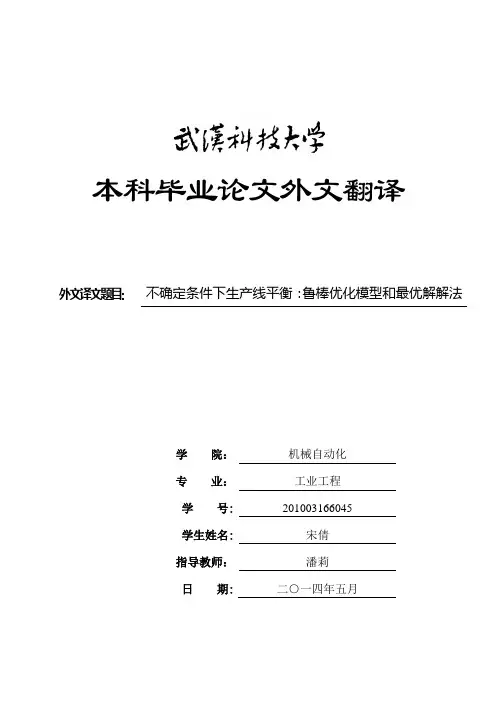
本科毕业论文外文翻译外文译文题目:不确定条件下生产线平衡:鲁棒优化模型和最优解解法学院:机械自动化专业:工业工程学号: 201003166045学生姓名: 宋倩指导教师:潘莉日期: 二○一四年五月Assembly line balancing under uncertainty: Robust optimization modelsand exact solution methodÖncü Hazır , Alexandre DolguiComputers &Industrial Engineering,2013,65:261–267不确定条件下生产线平衡:鲁棒优化模型和最优解解法安库·汉泽,亚历山大·多桂计算机与工业工程,2013,65:261–267摘要这项研究涉及在不确定条件下的生产线平衡,并提出两个鲁棒优化模型。
假设了不确定性区间运行的时间。
该方法提出了生成线设计方法,使其免受混乱的破坏。
基于分解的算法开发出来并与增强策略结合起来解决大规模优化实例.该算法的效率已被测试,实验结果也已经发表。
本文的理论贡献在于文中提出的模型和基于分解的精确算法的开发.另外,基于我们的算法设计出的基于不确定性整合的生产线的产出率会更高,因此也更具有实际意义。
此外,这是一个在装配线平衡问题上的开创性工作,并应该作为一个决策支持系统的基础。
关键字:装配线平衡;不确定性; 鲁棒优化;组合优化;精确算法1.简介装配线就是包括一系列在车间中进行连续操作的生产系统。
零部件依次向下移动直到完工。
它们通常被使用在高效地生产大量地标准件的工业行业之中。
在这方面,建模和解决生产线平衡问题也鉴于工业对于效率的追求变得日益重要。
生产线平衡处理的是分配作业到工作站来优化一些预定义的目标函数。
那些定义操作顺序的优先关系都是要被考虑的,同时也要对能力或基于成本的目标函数进行优化。
就生产(绍尔,1999)产品型号的数量来说,装配线可分为三类:单一模型(SALBP),混合模型(MALBP)和多模式(MMALBP)。
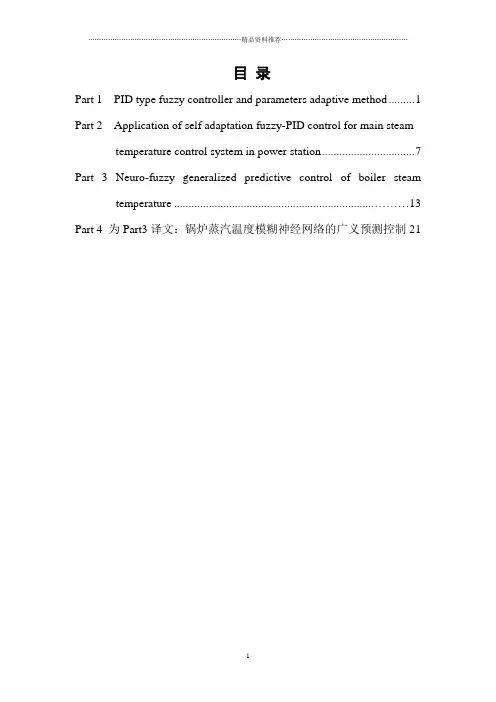
目录Part 1 PID type fuzzy controller and parameters adaptive method (1)Part 2 Application of self adaptation fuzzy-PID control for main steam temperature control system in power station (7)Part 3 Neuro-fuzzy generalized predictive control of boiler steam temperature ..................................................................... (13)Part 4 为Part3译文:锅炉蒸汽温度模糊神经网络的广义预测控制21Part 1 PID type fuzzy controller and Parametersadaptive methodWu zhi QIAO, Masaharu MizumotoAbstract: The authors of this paper try to analyze the dynamic behavior of the product-sum crisp type fuzzy controller, revealing that this type of fuzzy controller behaves approximately like a PD controller that may yield steady-state error for the control system. By relating to the conventional PID control theory, we propose a new fuzzy controller structure, namely PID type fuzzy controller which retains the characteristics similar to the conventional PID controller. In order to improve further the performance of the fuzzy controller, we work out a method to tune the parameters of the PID type fuzzy controller on line, producing a parameter adaptive fuzzy controller. Simulation experiments are made to demonstrate the fine performance of these novel fuzzy controller structures.Keywords: Fuzzy controller; PID control; Adaptive control1. IntroductionAmong various inference methods used in the fuzzy controller found in literatures , the most widely used ones in practice are the Mamdani method proposed by Mamdani and his associates who adopted the Min-max compositional rule of inference based on an interpretation of a control rule as a conjunction of the antecedent and consequent, and the product-sum method proposed by Mizumoto who suggested to introduce the product and arithmetic mean aggregation operators to replace the logical AND (minimum) and OR (maximum) calculations in the Min-max compositional rule of inference.In the algorithm of a fuzzy controller, the fuzzy function calculation is also a complicated and time consuming task. Tagagi and Sugeno proposed a crisp type model in which the consequent parts of the fuzzy control rules are crisp functional representation or crisp real numbers in the simplified case instead of fuzzy sets . With this model of crisp real number output, the fuzzy set of the inference consequence willbe a discrete fuzzy set with a finite number of points, this can greatly simplify the fuzzy function algorithm.Both the Min-max method and the product-sum method are often applied with the crisp output model in a mixed manner. Especially the mixed product-sum crisp model has a fine performance and the simplest algorithm that is very easy to be implemented in hardware system and converted into a fuzzy neural network model. In this paper, we will take account of the product-sum crisp type fuzzy controller.2. PID type fuzzy controller structureAs illustrated in previous sections, the PD function approximately behaves like a parameter time-varying PD controller. Since the mathematical models of most industrial process systems are of type, obviously there would exist an steady-state error if they are controlled by this kind of fuzzy controller. This characteristic has been stated in the brief review of the PID controller in the previous section.If we want to eliminate the steady-state error of the control system, we can imagine to substitute the input (the change rate of error or the derivative of error) of the fuzzy controller with the integration of error. This will result the fuzzy controller behaving like a parameter time-varying PI controller, thus the steady-state error is expelled by the integration action. However, a PI type fuzzy controller will have a slow rise time if the P parameters are chosen small, and have a large overshoot if the P or I parameters are chosen large. So there may be the time when one wants to introduce not only the integration control but the derivative control to the fuzzy control system, because the derivative control can reduce the overshoot of the system's response so as to improve the control performance. Of course this can be realized by designing a fuzzy controller with three inputs, error, the change rate of error and the integration of error. However, these methods will be hard to implement in practice because of the difficulty in constructing fuzzy control rules. Usually fuzzy control rules are constructed by summarizing the manual control experience of an operator who has been controlling the industrial process skillfully and successfully. The operator intuitively regulates the executor to control the process by watching theerror and the change rate of the error between the system's output and the set-point value. It is not the practice for the operator to observe the integration of error. Moreover, adding one input variable will greatly increase the number of control rules, the constructing of fuzzy control rules are even more difficult task and it needs more computation efforts. Hence we may want to design a fuzzy controller that possesses the fine characteristics of the PID controller by using only the error and the change rate of error as its inputs.One way is to have an integrator serially connected to the output of the fuzzy controller as shown in Fig. 1. In Fig. 1,1K and 2K are scaling factors for e and ~ respectively, and fl is the integral constant. In the proceeding text, for convenience, we did not consider the scaling factors. Here in Fig. 2, when we look at the neighborhood of NODE point in the e - ~ plane, it follows from (1) that the control input to the plant can be approximated by(1)Hence the fuzzy controller becomes a parameter time-varying PI controller, itsequivalent proportional control and integral control components are BK2D and ilK1 P respectively. We call this fuzzy controller as the PI type fuzzy controller (PI fc). We can hope that in a PI type fuzzy control system, the steady-state error becomes zero.To verify the property of the PI type fuzzy controller, we carry out some simulation experiments. Before presenting the simulation, we give a description of the simulation model. In the fuzzy control system shown in Fig. 3, the plant model is a second-order and type system with the following transfer function:)1)(1()(21++=s T s T K s G (2) Where K = 16, 1T = 1, and 2T = 0.5. In our simulation experiments, we use thediscrete simulation method, the results would be slightly different from that of a continuous system, the sampling time of the system is set to be 0.1 s. For the fuzzy controller, the fuzzy subsets of e and d are defined as shown in Fig. 4. Their coresThe fuzzy control rules are represented as Table 1. Fig. 5 demonstrates the simulation result of step response of the fuzzy control system with a Pl fc. We can see that the steady-state error of the control system becomes zero, but when the integration factor fl is small, the system's response is slow, and when it is too large, there is a high overshoot and serious oscillation. Therefore, we may want to introduce the derivative control law into the fuzzy controller to overcome the overshoot and instability. We propose a controller structure that simply connects the PD type and the PI type fuzzy controller together in parallel. We have the equivalent structure of that by connecting a PI device with the basic fuzzy controller serially as shown in Fig.6. Where ~ is the weight on PD type fuzzy controller and fi is that on PI type fuzzy controller, the larger a/fi means more emphasis on the derivative control and less emphasis on the integration control, and vice versa. It follows from (7) that the output of the fuzzy controller is(3)3. The parameter adaptive methodThus the fuzzy controller behaves like a time-varying PID controller, its equivalent proportional control, integral control and derivative control components are respectively. We call this new controller structure a PID type fuzzy controller (PID fc). Figs. 7 and 8 are the simulation results of the system's step response of such control system. The influence of ~ and fl to the system performance is illustrated. When ~ > 0 and/3 = 0, meaning that the fuzzy controller behaves like PD fc, there exist a steady-state error. When ~ = 0 and fl > 0, meaning that the fuzzy controller behaves like a PI fc, the steady-state error of the system is eliminated but there is a large overshoot and serious oscillation.When ~ > 0 and 13 > 0 the fuzzy controller becomes a PID fc, the overshoot is substantially reduced. It is possible to get a comparatively good performance by carefully choosing the value of αandβ.4. ConclusionsWe have studied the input-output behavior of the product-sum crisp type fuzzy controller, revealing that this type of fuzzy controller behaves approximately like a parameter time-varying PD controller. Therefore, the analysis and designing of a fuzzy control system can take advantage of the conventional PID control theory. According to the coventional PID control theory, we have been able to propose some improvement methods for the crisp type fuzzy controller.It has been illustrated that the PD type fuzzy controller yields a steady-state error for the type system, the PI type fuzzy controller can eliminate the steady-state error. We proposed a controller structure, that combines the features of both PD type and PI type fuzzy controller, obtaining a PID type fuzzy controller which allows the control system to have a fast rise and a small overshoot as well as a short settling time.To improve further the performance of the proposed PID type fuzzy controller, the authors designed a parameter adaptive fuzzy controller. The PID type fuzzy controller can be decomposed into the equivalent proportional control, integral control and the derivative control components. The proposed parameter adaptive fuzzy controller decreases the equivalent integral control component of the fuzzy controller gradually with the system response process time, so as to increase the damping of the system when the system is about to settle down, meanwhile keeps the proportional control component unchanged so as to guarantee quick reaction against the system's error. With the parameter adaptive fuzzy controller, the oscillation of the system is strongly restrained and the settling time is shortened considerably.We have presented the simulation results to demonstrate the fine performance of the proposed PID type fuzzy controller and the parameter adaptive fuzzy controller structure.Part 2 Application of self adaptation fuzzy-PID control for main steam temperature control system inpower stationZHI-BIN LIAbstract: In light of the large delay, strong inertia, and uncertainty characteristics of main steam temperature process, a self adaptation fuzzy-PID serial control system is presented, which not only contains the anti-disturbance performance of serial control, but also combines the good dynamic performance of fuzzy control. The simulation results show that this control system has more quickly response, better precision and stronger anti-disturbance ability.Keywords:Main steam temperature;Self adaptation;Fuzzy control;Serial control1. IntroductionThe boiler superheaters of modem thermal power station run under the condition of high temperature and high pressure, and the superheater’s temperature is highest in the steam channels.so it has important effect to the running of the whole thermal power station.If the temperature is too high, it will be probably burnt out. If the temperature is too low ,the efficiency will be reduced So the main steam temperature mast be strictly controlled near the given value.Fig l shows the boiler main steam temperature system structure.Fig.1 boiler main steam temperature systemIt can be concluded from Fig l that a good main steam temperature controlsystem not only has adequately quickly response to flue disturbance and load fluctuation, but also has strong control ability to desuperheating water disturbance. The general control scheme is serial PID control or double loop control system with derivative. But when the work condition and external disturbance change large, the performance will become instable. This paper presents a self adaptation fuzzy-PID serial control system. which not only contains the anti-disturbance performance of serial control, but also combines the good dynamic character and quickly response of fuzzy control .1. Design of Control SystemThe general regulation adopts serial PID control system with load feed forward .which assures that the main steam temperature is near the given value 540℃in most condition .If parameter of PID control changeless and the work condition and external disturbance change large, the performance will become in stable .The fuzzy control is fit for controlling non-linear and uncertain process. The general fuzzy controller takes error E and error change ratio EC as input variables .actually it is a non-linear PD controller, so it has the good dynamic performance .But the steady error is still in existence. In linear system theory, integral can eliminate the steady error. So if fuzzy control is combined with PI control, not only contains the anti-disturbance performance of serial control, but also has the good dynamic performance and quickly response.In order to improve fuzzy control self adaptation ability, Prof .Long Sheng-Zhao and Wang Pei-zhuang take the located in bringing forward a new idea which can modify the control regulation online .This regulation is:]1,0[,)1(∈-+=αααEC E UThis control regulation depends on only one parameter α.Once αis fixed .the weight of E and EC will be fixed and the self adaptation ability will be very small .It was improved by Prof. Li Dong-hui and the new regulation is as follow;]1,0[,,,3,)1(2,)1(1,)1(0,)1({321033221100∈±=-+±=-+±=-+=-+=ααααααααααααE EC E E EC E E EC E E EC E UBecause it is very difficult to find a self of optimum parameter, a new method is presented by Prof .Zhou Xian-Lan, the regulation is as follow:)0(),ex p(12>--=k ke αBut this algorithm still can not eliminate the steady error .This paper combines this algorithm with PI control ,the performance is improved .2. Simulation of Control System3.1 Dynamic character of controlled objectPapers should be limited to 6 pages Papers longer than 6 pages will be subject to extra fees based on their length .Fig .2 main steam temperature control system structureFig 2 shows the main steam temperature control system structure ,)(),(21s W s W δδare main controller and auxiliary controller,)(),(21s W s W o o are characters of the leading and inertia sections,)(),(21s W s W H H are measure unit.3.2 Simulation of the general serial PID control systemThe simulation of the general serial PID control system is operated by MATLAB, the simulation modal is as Fig.3.Setp1 and Setp2 are the given value disturbance and superheating water disturb & rice .PID Controller1 and PID Controller2 are main controller and auxiliary controller .The parameter value which comes from references is as follow :667.37,074.0,33.31)(25)(111111122===++===D I p D I p p k k k s k sk k s W k s W δδFig.3. the general PID control system simulation modal3.3 Simulation of self adaptation fuzzy-PID control system SpacingThe simulation modal is as Fig 4.Auxiliary controller is:25)(22==p k s W δ.Main controller is Fuzzy-PI structure, and the PI controller is:074.0,33.31)(11111==+=I p I p k k s k k s W δFuzzy controller is realized by S-function, and the code is as fig.5.Fig.4. the fuzzy PID control system simulation modalFig 5 the S-function code of fuzzy control3.4 Comparison of the simulationGiven the same given value disturbance and the superheating water disturbance,we compare the response of fuzzy-PID control system with PID serial control system. The simulation results are as fig.6-7.From Fig6-7,we can conclude that the self adaptation fuzzy-PID control system has the more quickly response, smaller excess and stronger anti-disturbance.4. Conclusion(1)Because it combines the advantage of PID controller and fuzzy controller, theself adaptation fuzzy-PID control system has better performance than the general PID serial control system.(2)The parameter can self adjust according to the error E value. so this kind of controller can harmonize quickly response with system stability.Part 3 Neuro-fuzzy generalized predictive controlof boiler steam temperatureXiangjie LIU, Jizhen LIU, Ping GUANAbstract: Power plants are nonlinear and uncertain complex systems. Reliable control of superheated steam temperature is necessary to ensure high efficiency and high load-following capability in the operation of modern power plant. A nonlinear generalized predictive controller based on neuro-fuzzy network (NFGPC) is proposed in this paper. The proposed nonlinear controller is applied to control the superheated steam temperature of a 200MW power plant. From the experiments on the plant and the simulation of the plant, much better performance than the traditional controller is obtained.Keywords: Neuro-fuzzy networks; Generalized predictive control; Superheated steam temperature1. IntroductionContinuous process in power plant and power station are complex systems characterized by nonlinearity, uncertainty and load disturbance. The superheater is an important part of the steam generation process in the boiler-turbine system, where steam is superheated before entering the turbine that drives the generator. Controlling superheated steam temperature is not only technically challenging, but also economically important.From Fig.1,the steam generated from the boiler drum passes through the low-temperature superheater before it enters the radiant-type platen superheater. Water is sprayed onto the steam to control the superheated steam temperature in both the low and high temperature superheaters. Proper control of the superheated steam temperature is extremely important to ensure the overall efficiency and safety of the power plant. It is undesirable that the steam temperature is too high, as it can damage the superheater and the high pressure turbine, or too low, as it will lower the efficiency of the power plant. It is also important to reduce the temperaturefluctuations inside the superheater, as it helps to minimize mechanical stress that causes micro-cracks in the unit, in order to prolong the life of the unit and to reduce maintenance costs. As the GPC is derived by minimizing these fluctuations, it is amongst the controllers that are most suitable for achieving this goal.The multivariable multi-step adaptive regulator has been applied to control the superheated steam temperature in a 150 t/h boiler, and generalized predictive control was proposed to control the steam temperature. A nonlinear long-range predictive controller based on neural networks is developed into control the main steam temperature and pressure, and the reheated steam temperature at several operating levels. The control of the main steam pressure and temperature based on a nonlinear model that consists of nonlinear static constants and linear dynamics is presented in that.Fig.1 The boiler and superheater steam generation process Fuzzy logic is capable of incorporating human experiences via the fuzzy rules. Nevertheless, the design of fuzzy logic controllers is somehow time consuming, as the fuzzy rules are often obtained by trials and errors. In contrast, neural networks not only have the ability to approximate non-linear functions with arbitrary accuracy, they can also be trained from experimental data. The neuro-fuzzy networks developed recently have the advantages of model transparency of fuzzy logic and learning capability of neural networks. The NFN is have been used to develop self-tuning control, and is therefore a useful tool for developing nonlinear predictive control. Since NFN is can be considered as a network that consists of several local re-gions, each of which contains a local linear model, nonlinear predictive control based onNFN can be devised with the network incorporating all the local generalized predictive controllers (GPC) designed using the respective local linear models. Following this approach, the nonlinear generalized predictive controllers based on the NFN, or simply, the neuro-fuzzy generalized predictive controllers (NFG-PCs)are derived here. The proposed controller is then applied to control the superheated steam temperature of the 200MW power unit. Experimental data obtained from the plant are used to train the NFN model, and from which local GPC that form part of the NFGPC is then designed. The proposed controller is tested first on the simulation of the process, before applying it to control the power plant.2. Neuro-fuzzy network modellingConsider the following general single-input single-output nonlinear dynamic system:),1(),...,(),(),...,1([)(''+-----=uy n d t u d t u n t y t y f t y ∆+--/)()](),...,1('t e n t e t e e (1)where f[.]is a smooth nonlinear function such that a Taylor series expansion exists, e(t)is a zero mean white noise and Δis the differencing operator,''',,e u y n n n and d are respectively the known orders and time delay of the system. Let the local linear model of the nonlinear system (1) at the operating point )(t o be given by the following Controlled Auto-Regressive Integrated Moving Average (CARIMA) model:)()()()()()(111t e z C t u z B z t y z A d ----+∆= (2) Where )()(),()(1111----∆=z andC z B z A z A are polynomials in 1-z , the backward shift operator. Note that the coefficients of these polynomials are a function of the operating point )(t o .The nonlinear system (1) is partitioned into several operating regions, such that each region can be approximated by a local linear model. Since NFN is a class of associative memory networks with knowledge stored locally, they can be applied to model this class of nonlinear systems. A schematic diagram of the NFN is shown in Fig.2.B-spline functions are used as the membership functions in theNFN for the following reasons. First, B-spline functions can be readily specified by the order of the basis function and the number of inner knots. Second, they are defined on a bounded support, and the output of the basis function is always positive, i.e.,],[,0)(j k j j k x x λλμ-∉=and ],[,0)(j k j j k x x λλμ-∈>.Third, the basis functions form a partition of unity, i.e.,.][,1)(min,∑∈≡j mam j k x x x x μ(3)And fourth, the output of the basis functions can be obtained by a recurrence equation.Fig. 2 neuro-fuzzy network The membership functions of the fuzzy variables derived from the fuzzy rules can be obtained by the tensor product of the univariate basis functions. As an example, consider the NFN shown in Fig.2, which consists of the following fuzzy rules: IF operating condition i (1x is positive small, ... , and n x is negative large),THEN the output is given by the local CARIMA model i:...)()(ˆ...)1(ˆ)(ˆ01+-∆+-++-=d t u b n t y a t y a t yi i a i in i i i a )(...)()(c i in i b i in n t e c t e n d t u b c b -+++--∆+ (4)or )()()()()(ˆ)(111t e z C t u z B z t yz A i i i i d i i ----+∆= (5) Where )()(),(111---z andC z B z A i i i are polynomials in the backward shift operator 1-z , and d is the dead time of the plant,)(t u i is the control, and )(t e i is a zero mean independent random variable with a variance of 2δ. The multivariate basis function )(k i x a is obtained by the tensor products of the univariate basis functions,p i x A a nk k i k i ,...,2,1,)(1==∏=μ (6)where n is the dimension of the input vector x , and p , the total number of weights in the NFN, is given by,∏=+=nk i i k R p 1)( (7)Where i k and i R are the order of the basis function and the number of inner knots respectively. The properties of the univariate B-spline basis functions described previously also apply to the multivariate basis function, which is defined on the hyper-rectangles. The output of the NFN is,∑∑∑=====p i i i p i ip i i i a y aa yy 111ˆˆˆ (8) 3. Neuro-fuzzy modelling and predictive control of superheatedsteam temperatureLet θbe the superheated steam temperature, and θμ, the flow of spray water to the high temperature superheater. The response of θcan be approximated by a second order model:The linear models, however, only a local model for the selected operating point. Since load is the unique antecedent variable, it is used to select the division between the local regions in the NFN. Based on this approach, the load is divided into five regions as shown in Fig.3,using also the experience of the operators, who regard a load of 200MW as high,180MW as medium high,160MW as medium,140MW as medium low and 120MW as low. For a sampling interval of 30s , the estimated linear local models )(1-z A used in the NFN are shown in Table 1.Fig. 3 Membership function for local modelsTable 1 Local CARIMA models in neuro-fuzzy modelCascade control scheme is widely used to control the superheated steam temperature. Feed forward control, with the steam flow and the gas temperature as inputs, can be applied to provide a faster response to large variations in these two variables. In practice, the feed forward paths are activated only when there are significant changes in these variables. The control scheme also prevents the faster dynamics of the plant, i.e., the spray water valve and the water/steam mixing, from affecting the slower dynamics of the plant, i.e., the high temperature superheater. With the global nonlinear NFN model in Table 1, the proposed NFGPC scheme is shown in Fig.4.Fig. 4 NFGPC control of superheated steam temperature with feed-for-ward control.As a further illustration, the power plant is simulated using the NFN model given in Table 1,and is controlled respectively by the NFGPC, the conventional linear GPC controller, and the cascaded PI controller while the load changes from 160MW to 200MW.The conventional linear GPC controller is the local controller designed for the“medium”operating region. The results are shown in Fig.5,showing that, as expected, the best performance is obtained from the NFGPC as it is designed based on a more accurate process model. This is followed by the conventional linear GPC controller. The performance of the conventional cascade PI controller is the worst, indicating that it is unable to control satisfactory the superheated steam temperature under large load changes. This may be the reason for controlling the power plant manually when there are large load changes.Fig.5 comparison of the NFGPC, conventional linear GPC, and cascade PI controller.4. ConclusionsThe modeling and control of a 200 MW power plant using the neuro-fuzzy approach is presented in this paper. The NFN consists of five local CARIMA models.The out-put of the network is the interpolation of the local models using memberships given by the B-spline basis functions. The proposed NFGPC is similarly constructed, which is designed from the CARIMA models in the NFN. The NFGPC is most suitable for processes with smooth nonlinearity, such that its full operating range can be partitioned into several local linear operating regions. The proposed NFGPC therefore provides a useful alternative for controlling this class of nonlinear power plants, which are formerly difficult to be controlled using traditional methods.Part 4 为Part3译文:锅炉蒸汽温度模糊神经网络的广义预测控制Xiangjie LIU, Jizhen LIU, Ping GUAN摘要:发电厂是非线性和不确定性的复杂系统。
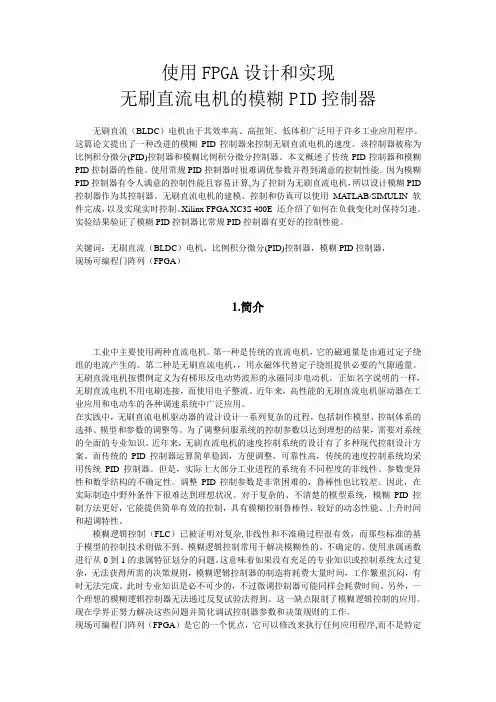
使用FPGA设计和实现无刷直流电机的模糊PID控制器无刷直流(BLDC)电机由于其效率高、高扭矩、低体积广泛用于许多工业应用程序。
这篇论文提出了一种改进的模糊PID控制器来控制无刷直流电机的速度。
该控制器被称为比例积分微分(PID)控制器和模糊比例积分微分控制器。
本文概述了传统PID控制器和模糊PID控制器的性能。
使用常规PID控制器时很难调优参数并得到满意的控制性能。
因为模糊PID控制器有令人满意的控制性能且容易计算,为了控制为无刷直流电机,所以设计模糊PID 控制器作为其控制器。
无刷直流电机的建模、控制和仿真可以使用MATLAB/SIMULIN软件完成,以及实现实时控制。
Xilinx FPGA XC3S 400E 还介绍了如何在负载变化时保持匀速。
实验结果验证了模糊PID控制器比常规PID控制器有更好的控制性能。
关键词:无刷直流(BLDC)电机,比例积分微分(PID)控制器,模糊PID控制器,现场可编程门阵列(FPGA)1.简介工业中主要使用两种直流电机。
第一种是传统的直流电机,它的磁通量是由通过定子绕组的电流产生的。
第二种是无刷直流电机,,用永磁体代替定子绕组提供必要的气隙通量。
无刷直流电机按惯例定义为有梯形反电动势波形的永磁同步电动机。
正如名字说明的一样,无刷直流电机不用电刷连接,而使用电子整流。
近年来,高性能的无刷直流电机驱动器在工业应用和电动车的各种调速系统中广泛应用。
在实践中,无刷直流电机驱动器的设计设计一系列复杂的过程,包括制作模型、控制体系的选择、模型和参数的调整等。
为了调整伺服系统的控制参数以达到理想的结果,需要对系统的全面的专业知识。
近年来,无刷直流电机的速度控制系统的设计有了多种现代控制设计方案。
而传统的PID控制器运算简单稳固,方便调整,可靠性高,传统的速度控制系统均采用传统PID控制器。
但是,实际上大部分工业进程的系统有不同程度的非线性、参数变异性和数学结构的不确定性。
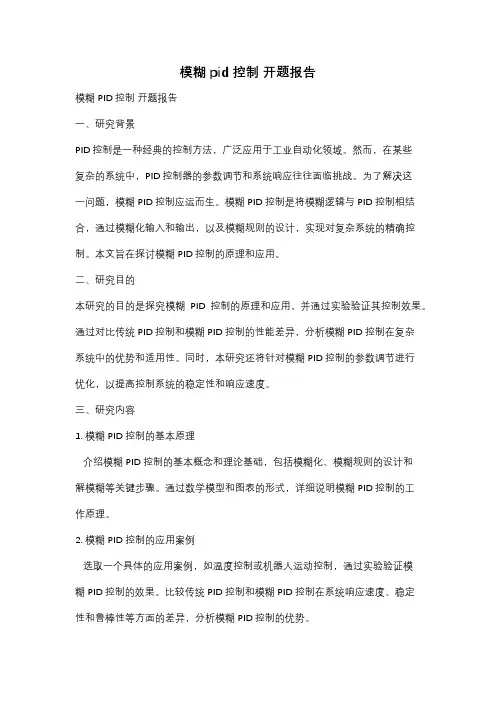
模糊pid控制开题报告模糊PID控制开题报告一、研究背景PID控制是一种经典的控制方法,广泛应用于工业自动化领域。
然而,在某些复杂的系统中,PID控制器的参数调节和系统响应往往面临挑战。
为了解决这一问题,模糊PID控制应运而生。
模糊PID控制是将模糊逻辑与PID控制相结合,通过模糊化输入和输出,以及模糊规则的设计,实现对复杂系统的精确控制。
本文旨在探讨模糊PID控制的原理和应用。
二、研究目的本研究的目的是探究模糊PID控制的原理和应用,并通过实验验证其控制效果。
通过对比传统PID控制和模糊PID控制的性能差异,分析模糊PID控制在复杂系统中的优势和适用性。
同时,本研究还将针对模糊PID控制的参数调节进行优化,以提高控制系统的稳定性和响应速度。
三、研究内容1. 模糊PID控制的基本原理介绍模糊PID控制的基本概念和理论基础,包括模糊化、模糊规则的设计和解模糊等关键步骤。
通过数学模型和图表的形式,详细说明模糊PID控制的工作原理。
2. 模糊PID控制的应用案例选取一个具体的应用案例,如温度控制或机器人运动控制,通过实验验证模糊PID控制的效果。
比较传统PID控制和模糊PID控制在系统响应速度、稳定性和鲁棒性等方面的差异,分析模糊PID控制的优势。
3. 模糊PID控制参数调节的优化方法针对模糊PID控制中参数调节的问题,提出一种优化方法。
该方法可以通过自适应调节策略或基于遗传算法的优化算法,自动调整模糊PID控制器的参数,以提高控制系统的性能。
四、研究方法本研究将采用实验研究和理论分析相结合的方法。
首先,通过搭建实验平台,选取一个具体的应用案例,进行传统PID控制和模糊PID控制的对比实验。
然后,根据实验数据,对比两种控制方法的性能差异。
同时,通过数学模型和理论分析,探讨模糊PID控制的原理和应用。
五、研究意义模糊PID控制作为一种新兴的控制方法,具有广阔的应用前景。
通过本研究,可以深入了解模糊PID控制的原理和应用,为工业自动化领域提供更加精确和稳定的控制方案。

文献综述电气工程及其自动化基于Fuzzy推理的PID控制器设计前言偏差的比例(proportional)、积分(Integral)和微分(Derivative)的综合控制,简称PID 控【1】。
PID 控制器本身是一种基于对“过去”、“现在”和“未来”信息估计的简单但却有效的控制算法。
由于其算法简单、鲁棒性能好、可靠性高等优点,PID 控制策略被广泛应用于工业过程控制【3】。
模糊控制一直是智能控制研究的热点,其应用水平代表着产品智能化水平,模糊控制以其控制简单、实现成本低廉、无需建立数学模型等独到的优点被广泛应用于家电等控制中,尤其是在时变、非线性的液压控制系统中得到广泛的应用。
如果将两者结合,利用模糊规则调整PID 参数的大小,可满足实时控制的要求,使其对输出转速控制达到理想的效【4】。
主题一:模糊控制的发展1965年扎德在《信息与控制》杂志上先后发表了"模糊集"(Fuzzy Sets)和"模糊集与子系统"(Fuzzy Sets & Systems),产生了模糊集合论,奠定了模糊集理论和应用研究的基础。
但"模糊"一词却在美国科技界遭到怀疑和反对,为此而影响了模糊逻辑在美国的研究和应用推广。
1968年扎德首次公开发表其"模糊算法"。
1973年发表了语言与模糊逻辑相结合的系统建立方法。
1974年伦敦大学Mamdani博士首次尝试利用模糊逻辑,成功地开发了世界上第一台模糊控制的蒸气引擎。
1965~1974年是模糊控制发展的第一阶段,即模糊数学发展与成形阶段。
其间于1972年,日本模糊系统研究基金会建立,后来成为国际模糊系统协会(IFSA)的日本办事处。
第二阶段大约从1974~1979年,这是产生简单模糊控制器的阶段。
在这期间,美国加州一公司率先生产了世上第一只模糊逻辑芯片。
1980年丹麦的斯密司公司首次应用芯片在水泥烘干机中成功地实现了模糊逻辑控制,但其自适应能力和鲁棒性有限,稳态精度也不够理想。

模糊PID开题报告1. 引言PID(Proportional-Integral-Derivative)控制器是一种经典的控制算法,广泛应用于自动化控制领域。
然而,在某些场景下,传统的PID控制器可能面临一些挑战,如非线性系统、不确定性、多变量系统等。
为了克服这些问题,模糊控制算法被引入。
本文将介绍模糊PID控制器的开题报告,主要包括问题陈述、研究目标、研究内容和研究方法。
2. 问题陈述在某些复杂的控制系统中,传统的PID控制算法效果不佳。
例如,控制非线性系统或具有不确定性的系统时,传统PID控制器可能无法提供足够的鲁棒性和稳定性。
因此,我们的问题陈述是如何改进PID控制器以应对这些挑战。
3. 研究目标本研究的目标是设计一个模糊PID控制器,以提高对非线性系统和具有不确定性的系统的控制效果。
通过引入模糊逻辑和模糊推理,我们希望改进传统PID控制器的性能。
4. 研究内容本研究的主要内容包括以下几个方面:4.1 模糊控制理论研究首先,我们将对模糊控制理论进行深入研究。
了解模糊控制的基本概念、原理和算法是设计模糊PID控制器的基础。
4.2 PID控制器分析在研究传统PID控制器的基础上,我们将分析其在非线性系统和具有不确定性的系统上的局限性。
通过分析PID控制器的性能瓶颈,我们可以更好地设计模糊PID控制器。
4.3 模糊PID控制器设计基于模糊控制理论和PID控制器分析的结果,我们将设计一个模糊PID控制器。
该控制器将结合传统PID控制的优点和模糊控制的鲁棒性,以提高对非线性系统和具有不确定性的系统的控制效果。
4.4 系统仿真与实验验证为了验证模糊PID控制器的性能,我们将进行系统仿真和实验验证。
通过对比传统PID控制器和模糊PID控制器的控制效果,我们可以评估模糊PID控制器的优势和局限性。
5. 研究方法本研究将采用以下研究方法:5.1 文献综述我们将进行大量的文献综述,深入了解模糊控制理论和PID控制器的相关研究成果。

摘要模糊控制是以模糊集合理论、模糊语言变量以及模糊逻辑推理为基础的一种计算机控制。
它处理的问题可能难以靠解析求解,需要采用复杂的数值计算方法。
由于模糊逻辑的迅速推广应用,Math Works公司已经添加了模糊逻辑控制工具箱。
利用MATLAB进行仿真就是比较合理的选择。
而PID控制器具有结构简单、容易实现、控制效果好、鲁棒性强等特点,是迄今为止最稳定的控制方法。
它所涉及的参数物理意义明确,理论分析体系完整,并为工程界所熟悉,因而在工业过程控制中得到了广泛应用。
从实际需要出发,一种好的PID控制器参数整定方法,不仅可以减少操作人员的负担,还可以使系统处于最佳运行状态。
因此,对PID控制器参数整定法的研究具有重要的实际意义。
进行传统的模拟和数字PID控制算法,并对传统的PID控制算法进行微分项和积分项的改进,学习了几种比较普遍运用的方法,如不完全微分PID控制算法、微分先行、遇限消弱积分PID控制算法等。
两者结合构成的模糊PID控制仿真研究表明模糊PID控制器具有在控制过程的前期阶段具有模糊控制器的优点,而在控制过程的后期阶段又具有PID调节器的所有优势,是一种性能优良的控制器。
关键词:模糊集合理论;PID控制;控制算法;参数整定;性能优良AbstractFuzzy control based on fuzzy set theory, fuzzy linguistic variables and fuzzy logic control based on a computer. It may be difficult to deal with the problem solved by the resolution required the use of complex numerical methods. Since the rapid popularization and application of fuzzy logic, Math Works has added a fuzzy logic control toolbox. Simulation using MATLAB is a reasonable choice. The PID controller has simple structure, easy to implement, control effect, robustness and other properties, is by far the most stable control. It involves a clear physical meaning of parameters, theoretical analysis system integrity, and engineering are familiar with, so in the industrial process control has been widely used. From the actual needs, a good tuning method of PID controller parameters can not only reduce the burden on operators, but also can make the system running at its best. Therefore, PID Controller Parameters Tuning of the study has important practical significance. The traditional analog and digital PID control algorithm, the traditional PID control algorithm and differential term and the integral term for the improvement of learning a few of the more commonly used methods such as PID control algorithm is not fully differential, differential first, the case of limited consumer Weak integral PID control algorithm. Combination of fuzzy PID control form simulation shows that fuzzy PID controller to control the early stage of the process has the advantages of fuzzy controller, while the later stages in the control process but also has all the advantages of PID regulator, is an excellent Controller.Key words:fuzzy set theory; PID control; control algorithm; parameter tuning; excellent performance目录摘要 (I)关键词 (I)Abstract (II)Key words (II)1 引言 (1)1.1 国内外研究进展 (1)1.2 本论文研究内容 (2)2 模糊控制 (3)2.1 模糊控制理论简介 (3)2.2 模糊控制理论的特点 (3)2.3 模糊控制系统的结构 (4)2.4 模糊控制器的设计 (4)2.5 利用MATLAB进行模糊控制仿真 (7)2.6 本章小结 (8)3 PID控制 (9)3.1 PID控制算法 (10)3.1.1 模拟PID控制算法 (10)3.1.2 数字式PID控制算法 (11)3.2 PID参数工程整定法 (13)3.3 改进的PID控制算法 (14)3.3.1 微分项的改进 (14)3.3.2 积分项的改进 (15)3.4 PID控制在工业加热炉中的应用 (18)3.5 本章小结 (20)4 模糊PID控制及其MATLAB仿真 (21)4.1 模糊PID控制的设计 (21)4.2 MATLAB编程和系统仿真 (22)4.2.1 模糊PID控制算法分析 (22)4.2.2 MATLAB仿真 (24)4.3 MATLAB仿真分析 (25)4.4 本章小结 (27)参考文献 (28)结束语 (29)致谢 (30)1 引言模糊控制是以模糊集合理论、模糊语言变量和模糊逻辑推理为基础的一种计算机控制方法,作为智能控制的一个重要分支,在控制领域获得了广泛应用,模糊控制与传统控制方式相比具有以下突出优点:(1) 不需要精确的被控对象的数学模型;(2) 使用自然语言方法,控制方法易于掌握;(3) 鲁棒性好,能够较大范围的适应参数变化;(4) 与常规PID控制相比,动态响应品质优良。
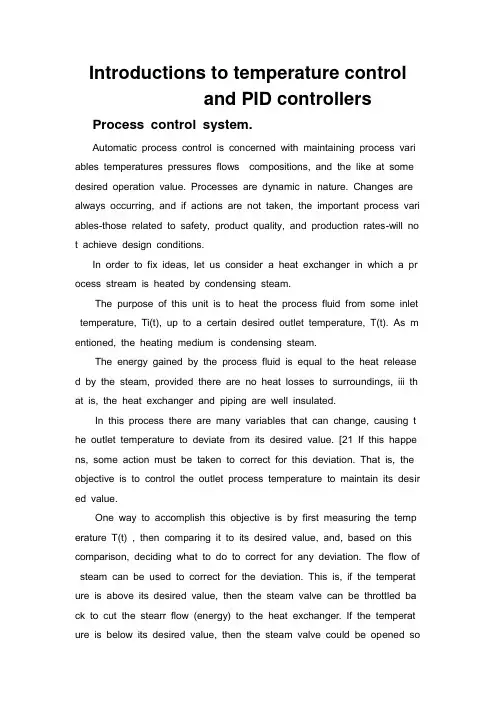
Introductions to temperature controland PID controllers Process control system.Automatic process control is concerned with maintaining process vari ables temperatures pressures flows compositions, and the like at some desired operation value. Processes are dynamic in nature. Changes are always occurring, and if actions are not taken, the important process vari ables-those related to safety, product quality, and production rates-will no t achieve design conditions.In order to fix ideas, let us consider a heat exchanger in which a pr ocess stream is heated by condensing steam.The purpose of this unit is to heat the process fluid from some inlet temperature, Ti(t), up to a certain desired outlet temperature, T(t). As m entioned, the heating medium is condensing steam.The energy gained by the process fluid is equal to the heat release d by the steam, provided there are no heat losses to surroundings, iii th at is, the heat exchanger and piping are well insulated.In this process there are many variables that can change, causing t he outlet temperature to deviate from its desired value. [21 If this happe ns, some action must be taken to correct for this deviation. That is, the objective is to control the outlet process temperature to maintain its desir ed value.One way to accomplish this objective is by first measuring the temp erature T(t) , then comparing it to its desired value, and, based on this comparison, deciding what to do to correct for any deviation. The flow of steam can be used to correct for the deviation. This is, if the temperat ure is above its desired value, then the steam valve can be throttled ba ck to cut the stearr flow (energy) to the heat exchanger. If the temperat ure is below its desired value, then the steam valve could be opened some more to increase the steam flow (energy) to the exchanger. All of th ese can be done manually by the operator, and since the procedure is f airly straightforward, it should present no problem. However, since in mo st process plants there are hundreds of variables that must be maintaine d at some desired value, this correction procedure would required a trem endous number of operators. Consequently, we would like to accomplish this control automatically. That is, we want to have instnnnents that contr ol the variables wJtbom requ)ring intervention from the operator. (si This is what we mean by automatic process control.To accomplish ~his objective a control system must be designed and implemented.The first thing to do is to measure the outlet temperaVare of the pro cess stream. A sensor (thermocouple, thermistors, etc) does this. This se nsor is connected physically to a transmitter, which takes the output from the sensor and converts it to a signal strong enough to be transmitter t o a controller. The controller then receives the signal, which is related to the temperature, and compares it with desired value. Depending on this comparison, the controller decides what to do to maintain the temperatu re at its desired value. Base on this decision, the controller then sends another signal to final control element, which in turn manipulates the ste am flow.The preceding paragraph presents the four basic components of all control systems. They are(1) sensor, also often called the primary element.(2) transmitter, also called the secondary element.(3) controller, the "brain" of the control system.(4) final control system, often a control valve but not always. Other common final control elements are variable speed pumps, conveyors, an d electric motors.The importance of these components is that they perform the three basic operations that must be present in every control system. These op erations are(1) Measurement (M) : Measuring the variable to be controlled is us ually done by the combination of sensor and transmitter.(2) Decision (D): Based on the measurement, the controller must the n decide what to do to maintain the variable at its desired value.(3) Action (A): As a result of the controller's decision, the system m ust then take an action. This is usually accomplished by the final control element.As mentioned, these three operations, M, D, and A, must be presen t in every control system.PID controllers can be stand-alone controllers (also called single loo p controllers), controllers in PLCs, embedded controllers, or software in V isual Basic or C# computer programs.PID controllers are process controllers with the following characteristi cs:Continuous process controlAnalog input (also known as "measuremem" or "Process Variable" or "PV")Analog output (referred to simply as "output")Setpoint (SP)Proportional (P), Integral (I), and/or Derivative (D) constantsExamples of "continuous process control" are temperature, pressure, flow, and level control. For example, controlling the heating of a tank. Fo r simple control, you have two temperature limit sensors (one low and o ne high) and then switch the heater on when the low temperature limit s ensor tums on and then mm the heater off when the temperature rises t o the high temperature limit sensor. This is similar to most home air con ditioning & heating thermostats.In contrast, the PID controller would receive input as the actual tem perature and control a valve that regulates the flow of gas to the heater. The PID controller automatically finds the correct (constant) flow of gas to the heater that keeps the temperature steady at the setpoint. Instead of the temperature bouncing back and forth between two points, the tem perature is held steady. If the setpoint is lowered, then the PID controller automatically reduces the amount of gas flowing to the heater. If the se tpoint is raised, then the PID controller automatically increases the amou nt of gas flowing to the heater. Likewise the PID controller would autom atically for hot, sunny days (when it is hotter outside the heater) and for cold, cloudy days.The analog input (measurement) is called the "process variable" or " PV". You want the PV to be a highly accurate indication of the process parameter you are trying to control. For example, if you want to maintain a temperature of + or -- one degree then we typically strive for at least ten times that or one-tenth of a degree. If the analog input is a 12 bit analog input and the temperature range for the sensor is 0 to 400 degre es then our "theoretical" accuracy is calculated to be 400 degrees divide d by 4,096 (12 bits) =0.09765625 degrees. [~] We say "theoretical" beca use it would assume there was no noise and error in our temperature s ensor, wiring, and analog converter. There are other assumptions such a s linearity, etc.. The point being--with 1/10 of a degree "theoretical" accur acy--even with the usual amount of noise and other problems-- one degr ee of accuracy should easily be attainable.The analog output is often simply referred to as "output". Often this is given as 0~100 percent. In this heating example, it would mean the v alve is totally closed (0%) or totally open (100%).The setpoint (SP) is simply--what process value do you want. In this example--what temperature do you want the process at?The PID controller's job is to maintain the output at a level so that t here is no difference (error) between the process variable (PV) and the setpoint (SP).In Fig. 3, the valve could be controlling the gas going to a heater, t he chilling of a cooler, the pressure in a pipe, the flow through a pipe, t he level in a tank, or any other process control system. What the PID c ontroller is looking at is the difference (or "error") between the PV and t he SP.It looks at the absolute error and the rate of change of error. Absolute error means--is there a big difference in the PV and SP or a little differ ence? Rate of change of error means--is the difference between the PV or SP getting smaller or larger as time goes on.When there is a "process upset", meaning, when the process variabl e or the setpoint quickly changes--the PID controller has to quickly chan ge the output to get the process variable back equal to the setpoint. If y ou have a walk-in cooler with a PID controller and someone opens the door and walks in, the temperature (process variable) could rise very qui ckly. Therefore the PID controller has to increase the cooling (output) to compensate for this rise in temperature.Once the PID controller has the process variable equal to the setpoi nt, a good PID controller will not vary the output. You want the output to be very steady (not changing) . If the valve (motor, or other control ele ment) is constantly changing, instead of maintaining a constant value, thi s could cause more wear on the control element.So there are these two contradictory goals. Fast response (fast chan ge in output) when there is a "process upset", but slow response (stead y output) when the PV is close to the setpoint.Note that the output often goes past (over shoots) the steady-state output to get the process back to the setpoint. For example, a cooler m ay normally have its cooling valve open 34% to maintain zero degrees (after the cooler has been closed up and the temperature settled down). If someone opens the cooler, walks in, walks around to find something, then walks back out, and then closes the cooler door--the PID controlle r is freaking out because the temperature may have raised 20 degrees! So it may crank the cooling valve open to 50, 75, or even 100 percent--to hurry up and cool the cooler back down--before slowly closing the co oling valve back down to 34 percent.Let's think about how to design a PID controller.We focus on the difference (error) between the process variable (PV) and the setpoint (SP). There are three ways we can view the error. The absolute errorThis means how big is the difference between the PV and SP. If th ere is a small difference between the PV and the SP--then let's make a small change in the output. If there is a large difference in the PV and SP--then let's make a large change in the output. Absolute error is the "proportional" (P) component of the PID controller.The sum of errors over timeGive us a minute and we will show why simply looking at the absol ute error (proportional) only is a problem. The sum of errors over time is important and is called the "integral" (I) component of the PID controller. Every time we run the PID algorithm we add the latest error to the su m of errors. In other words Sum of Errors = Error 1 q- Error2 + Error3 + Error4 + ....The dead timeDead time refers to the delay between making a change in the outp ut and seeing the change reflected in the PV. The classical example isgetting your oven at the right temperature. When you first mm on the he at, it takes a while for the oven to "heat up". This is the dead time. If y ou set an initial temperature, wait for the oven to reach the initial tempe rature, and then you determine that you set the wrong temperature--then it will take a while for the oven to reach the new temperature setpoint. This is also referred to as the "derivative" (D) component of the PID con troller. This holds some future changes back because the changes in the output have been made but are not reflected in the process variable ye t.Absolute Error/ProportionalOne of the first ideas people usually have about designing an autom atic process controller is what we call "proportional". Meaning, if the diffe rence between the PV and SP is small--then let's make a small correctio n to the output. If the difference between the PV and SP is large-- then let's make a larger correction to the output. This idea certainly makes s ense.We simulated a proportional only controller in Microsoft Excel. Fig.4 i s the chart showing the results of the first simulation (DEADTIME = 0, p roportional only):Proportional and Integral ControllersThe integral portion of the PID controller accounts for the offset prob lem in a proportional only controller. We have another Excel spreadsheet that simulates a PID controller with proportional and integral control. He re (Fig. 5) is a chart of the first simulation with proportional and integral (DEADTIME :0, proportional = 0.4).As you can tell, the PI controller is much better than just the P cont roller. However, dead time of zero (as shown in the graph) is not comm on.Derivative ControlDerivative control takes into consideration that if you change the out put, then it takes tim for that change to be reflected in the input (PV).Fo r example, let's take heating of the oven.If we start turning up the gas flow, it will take time for the heat to b e produced, the heat to flow around the oven, and for the temperature s ensor to detect the increased heat. Derivative control sort of "holds back " the PID controller because some increase in temperature will occur wit hout needing to increase the output further. Setting the derivative consta nt correctly allows you to become more aggressive with the P & I const ants.中文翻译温度控制简介和PID控制器过程控制系统自动过程控制系统是指将被控量为温度、压力、流量、成份等类型的过程变量保持在理想的运行值的系统。
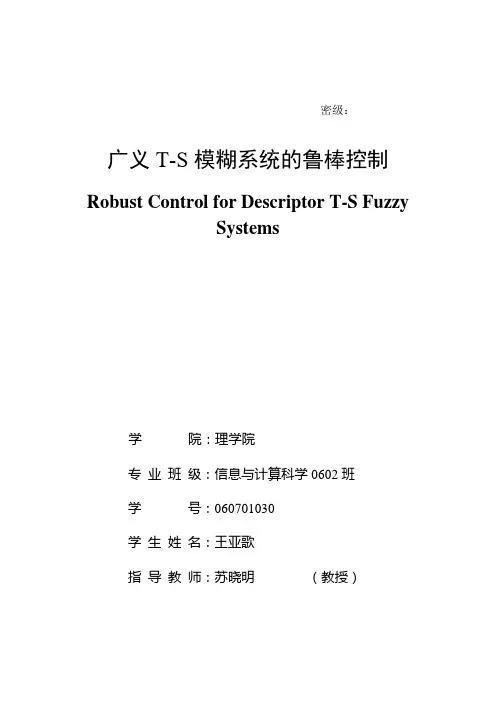
广义T-S模糊系统的鲁棒控制Robust Control for Descriptor T-S FuzzySystems学院:理学院专业班级:信息与计算科学0602班学号:060701030学生姓名:王亚歌指导教师:苏晓明(教授)2010年6月摘要在实际应用的控制系统中,各种时域上的硬约束条件是广泛存在的。
对控制系统的高性能要求,往往意味着需要较大的控制动作,这样就产生了高性能要求和满足时域硬约束之间的矛盾。
如果只考虑系统性能,而不考虑时域硬约束,求出的控制量也远远地超出了约束的范围。
在这种情况下,就不能保证闭环系统需要的性能,甚至可能会出现系统不稳定的现象。
所以说时域硬约束是控制器设计时必须考虑的因素。
广义T-S模糊系统是在T-S模糊系统模型与广义系统理论的基础上衍生的而来的,近年来,广义T-S模糊系统在控制理论、电路、经济、机械以及其它领域中得到了广泛应用。
因此,对广义T-S模糊系统进行研究具有重要的现实意义。
本文针对不确定广义T-S模糊系统,基于广义Lyapunov稳定性理论和椭圆不变域方法,利用线性矩阵不等式(LMI)技术,分别研究了系统的最优控制问题和H∞控制问题。
首先,考虑初始状态在非零情况下的不确定广义T-S模糊系统的最优控制问题,将系统输出能量作为优化性能指标,得到了优化性能指标和系统椭圆不变域的共同上界。
通过最小化系统的这个上界实现了广义T-S模糊系统的优化控制,同时可以用椭圆不变域来得到系统稳定的充分条件。
其次,当存在外部干扰时,进一步考虑不确定广义T-S模糊系统干扰抑制问题,用双椭圆域方法寻找到了满足时域硬约束的充分条件的约束H∞控制策略。
寻找到初始状态所在的一个椭圆域,在闭环系统满足一定的不等式并假设外部干扰的能量小于某个界的条件下,确定另一个包含系统所有可能状态的椭圆域。
从而得到依赖于这个椭圆域的满足时域硬约束的充分条件。
关键词:广义T-S模糊系统;时域硬约束;最优控制;H∞控制AbstractTime-domain hard constraints are probably the most widely existent in practice control systems. It is well recognized that performance requirements for control systems imply large control actions. All of these result in the conflict between high performance and satisfaction of time-domain hard constraints. If one ignores these constraints and only performance is treated, control action will exceed the bounds greatly. In such case, performance of closed-loop system wouldn‟t be guaranteed, even of stability. So time-domain hard constraints must be handled in some control system design.Descriptor T-S fuzzy system is a combination of both T-S fuzzy modular and descriptor system. Recently, there has extensive application in control theory, circuits, economics, mechanical systems and other areas. So it is of significant practical meaning to study the problem of descriptor T-S fuzzy system. Based on the descriptor Lyapunov theorem and the ellipsoidal invariant sets methods, by using linear matrix inequalities (LMI), in this article, the optimal regulation problem and H∞control problem for uncertain descriptor T-S fuzzy systems have been considered.First, considering the optimal regulation problem for uncertain descriptor T-S fuzzy system with non-zero initial state, we choose the energy of output as performance function, is the common super-bound for the performance and an ellipsoidal invariant set. So the optimal control can be realized by minimizing bound, and sufficient conditions dependent on the ellipsoidal invariant set for satisfying system stability are derived.Then, when external disturbance exists, further consideration disturbance restraint on uncertain descriptor T-S fuzzy system, we seek H∞control satisfying time-domain hard constraints with double-ellipsoidal-set. We seek an ellipsoidal set which includes initial state, with closed-loop system satisfying some inequation and under the bound assumption of the external disturbance energy, we seek another ellipsoidal set containing all possible condition, and sufficient conditions dependent on the ellipsoidal invariant set for satisfying time-domain hard constraints are derived.Keywords:Descriptor T-S fuzzy system; Time-domain hard constraints; Optimal regulation; H∞ control目录摘要 (I)Abstract (II)第1章绪论 (1)1.1课题背景 (1)1.2 广义T-S模糊系统模型的提出 (2)1.3 广义T-S模糊系统的研究意义 (4)1.4 广义T-S模糊系统的研究现状 (5)1.5 全文主要研究工作 (6)第2章预备知识 (7)2.1 广义T-S模糊系统描述 (7)2.2 平行分配补偿控制器 (8)2.3 广义T-S模糊系统稳定性分析 (9)2.4 线性矩阵不等式 (10)2.5 S-Procedure (13)2.6 小结 (15)第3章不确定广义T-S模糊系统的最优控制 (16)3.1 引言 (16)3.2 不确定广义T-S模糊系统描述 (16)3.3 不确定广义T-S模糊系统的最优控制 (19)3.4 小结 (28)控制 (29)第4章不确定广义T-S模糊系统的H∞4.1 引言 (29)4.2 问题描述 (29)4.3 不确定广义T-S模糊系统的H∞控制 (29)4.4 小结 (35)第5章结论 (36)参考文献 (38)致谢 (40)第1章绪论1.1课题背景美国加里福尼亚大学L.A.Zadeh教授在1965年提出的《Fuzzy set》开始了模糊控制的历史,从此模糊数学学科发展起来了。
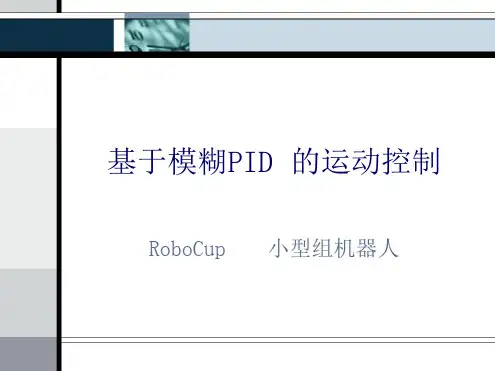
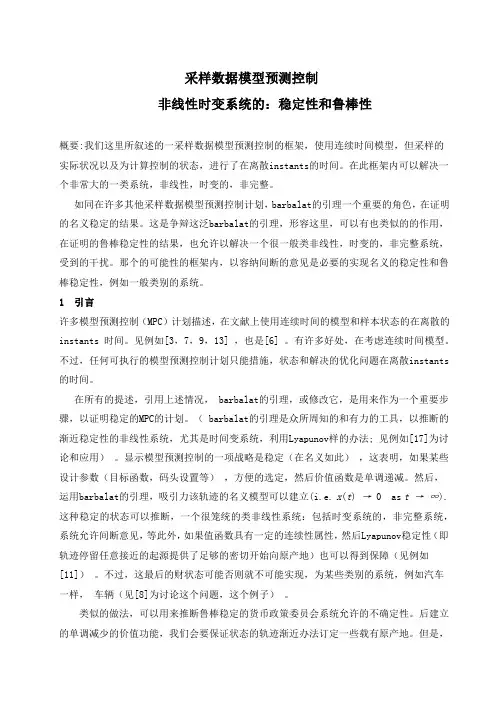
采样数据模型预测控制非线性时变系统的:稳定性和鲁棒性概要:我们这里所叙述的一采样数据模型预测控制的框架,使用连续时间模型,但采样的实际状况以及为计算控制的状态,进行了在离散instants的时间。
在此框架内可以解决一个非常大的一类系统,非线性,时变的,非完整。
如同在许多其他采样数据模型预测控制计划,barbalat的引理一个重要的角色,在证明的名义稳定的结果。
这是争辩这泛barbalat的引理,形容这里,可以有也类似的的作用,在证明的鲁棒稳定性的结果,也允许以解决一个很一般类非线性,时变的,非完整系统,受到的干扰。
那个的可能性的框架内,以容纳间断的意见是必要的实现名义的稳定性和鲁棒稳定性,例如一般类别的系统。
1 引言许多模型预测控制(MPC)计划描述,在文献上使用连续时间的模型和样本状态的在离散的instants 时间。
见例如[3,7,9,13] ,也是[6] 。
有许多好处,在考虑连续时间模型。
不过,任何可执行的模型预测控制计划只能措施,状态和解决的优化问题在离散instants 的时间。
在所有的提述,引用上述情况, barbalat的引理,或修改它,是用来作为一个重要步骤,以证明稳定的MPC的计划。
( barbalat的引理是众所周知的和有力的工具,以推断的渐近稳定性的非线性系统,尤其是时间变系统,利用Lyapunov样的办法; 见例如[17]为讨论和应用)。
显示模型预测控制的一项战略是稳定(在名义如此),这表明,如果某些设计参数(目标函数,码头设置等),方便的选定,然后价值函数是单调递减。
然后,运用barbalat 的引理,吸引力该轨迹的名义模型可以建立(i.e. x(t) →0as t →∞).这种稳定的状态可以推断,一个很笼统的类非线性系统:包括时变系统的,非完整系统,系统允许间断意见,等此外,如果值函数具有一定的连续性属性,然后Lyapunov稳定性(即轨迹停留任意接近的起源提供了足够的密切开始向原产地)也可以得到保障(见例如[11])。
利用模糊控制算法的系统鲁棒性研究1. 引言在现实世界中,许多系统都需要在不确定、模糊或者部分随机的环境中运作,例如,金融、航空、电力、交通等领域。
在这些领域中,精确的建模和完整的参数信息往往难以获得,同时,也面临着各种干扰、噪声和非线性等问题。
为了解决这些问题,模糊控制算法应运而生。
模糊控制通过模糊化变量和规则,处理不确定和难以量化的信息,从而实现对系统的控制。
但是,模糊控制算法本身也存在一些问题,如控制系统的稳定性和鲁棒性等方面。
因此,本文将着重探讨利用模糊控制算法的系统鲁棒性研究。
2. 模糊控制算法2.1 模糊集和模糊逻辑模糊控制算法的核心是模糊集和模糊逻辑。
模糊集是一种集合,其中的元素具有一定的隶属度,即使不是完全属于某个集合,也可能以部分成员的形式属于多个集合。
模糊逻辑是基于模糊集进行的逻辑操作,其运算复杂度较高,但是可以处理不确定和模糊的信息。
2.2 模糊控制器的组成模糊控制器由输入量、输出量和知识库三部分组成。
输入量为控制系统的状态变量,输出量为控制器的输出信号,知识库包含了模糊规则和模糊集合。
2.3 模糊规则的设计模糊规则是模糊逻辑控制的基本单元,其形式是“如果……那么……”。
模糊规则的设计需要根据实际情况确定输入变量、输出变量和隶属度函数。
隶属度函数可以是三角形、梯形或高斯模糊函数等形式。
3. 系统鲁棒性问题3.1 系统稳定性模糊控制算法的系统稳定性问题是目前研究的热点之一。
当系统存在多个稳定状态时,需要通过控制器将系统从一个状态转移到另一个状态。
如果控制器造成了不稳定性,则可能会导致系统崩溃。
因此,研究控制器稳定性,保证系统稳定性是十分重要的。
3.2 参数敏感性模糊控制算法的参数很大程度上决定了系统的效果,但是参数的选择往往需要根据具体的实验,并不能完全推广到其他系统上。
因此,模糊控制算法的参数敏感性是影响系统性能的因素之一。
当参数发生微小变化时,可能会导致控制器性能急剧下降。
模糊PID控制器的结果解析及其稳定性分析B.M. Mohan *, Arpita SinhaDepartment of Electrical Engineering, Indian Institute of Technology, Kharagpur 721302, India Received 14 July 2006; received in revised form 31 May 2007; accepted 10 June 2007 Available online 14 June 2007摘要:本文建立在三输入四输出变量模糊集的控制器基础之上对模糊PID控制器的解析。
该结构是基于对输入/输出为 ,L隶属度函数,代数积三角形准则、有界和三角形准则,Mamdami最小推理方式,中值法反模糊方式之上得出的。
文中的有界输入/输出稳定性的条件是基于小增益定理。
最后,以两个数值例子及其仿真结果来论证了最简模糊PID控制器的可行性和有效性。
1.介绍:由于传统PID控制器的简易性,鲁棒性好,对线性系统控制有效等优点,许多的工业控制仍采用这种控制方法。
本文图1给出了两种不同配置的PID控制器。
但由于其为线性结构,如果系统为高阶大时滞系统,非线性系统,没有精确数学模型的复杂模糊系统或是具有多个不确定因素的系统,传统的PID控制方法就无法非常有效地对其进行控制。
上个世纪90年代之前,大多数的模糊系统研究侧重在应用领域,而非理论研究。
直至1990年,研究人员才开始对模糊控制器进行结构解析及稳定性分析。
并如其他传统控制理论,针对一个对象,建立了模糊理论体系。
从模糊PI及模糊PD控制器与其对应传统控制器对上述复杂系统的控制结果的比较可看出其优越性。
由于模糊PI控制器比模糊PD控制器具有更好的优越性,模糊PD控制算法无法消除稳态误差。
但是,模糊PI控制器由于其自身的积分操作,在高阶系统时,并不能得到很好的控制效果。
模糊PID控制方法研究Fuzzy PID Controller2 模糊控制器的设计2.1 模糊控制器的基本原理2.1.1 模糊控制器的原理模糊控制(Fuzzy Control)是以模糊集理论、模糊语言变量和模糊逻辑推理为基础的一种智能控制方法,它从行为上模仿人的模糊推理和决策过程。
模糊控制是先将操作人员或专家经验编成模糊规则,然后将来自传感器的实时信号通过模糊规则模糊化,将模糊化后的信号作为模糊规则的输入,完成模糊推理,进行解模糊化,最后将解模糊后得到的输出量加到执行器上。
图2-1是模糊控制原理框图。
图2-1 模糊控制原理框图2.1.2 模糊控制器的组成在整个控制器中,模糊控制器是整个控制系统的核心,所采用的模糊规则、合成推理算法和模糊决策的方法等都是决定整个控制器优劣的因素。
其组成如图2-2:图2-2 模糊控制器的组成框图模糊化接口是模糊控制器的输入借口,主要作用是将真实的确定量输入转换为一个模糊矢量。
数据库和规则库共同组成了控制器的知识库,数据库中存放的是所有输入、输出变的的全部模糊子集的隶属度矢量值(即经过论域等级离散化以后对应值的集合)。
在规则推理的模糊关系方程求解过程中,向推理机提供数据。
规则库是对人类长期经验的总结,将其转化成模糊控制算法,为推理机提供控制规则。
推理是模糊控制器中,根据输入模糊量,模仿人类判断时的模糊概念,运用模糊逻辑和模糊推论法进行推论,而得到模糊控制讯号。
此部分是模糊控制器的精髓所在。
解模糊借口是将推论所得到的模糊值转换为明确的控制讯号,做为系统的输入值。
2.2 模糊控制器的设计步骤通过对模糊控制器原理的研究,得出设计模糊控制器主要包括以下几项内容:(1)确定模糊控制器的输入变量和输出变量(即控制量)。
输入变量为误差e以及误差变化ec,输出变量为控制量u。
e,ec,u的模糊集均为:{NB,NM,NS,ZO,PS,PM,PB}。
e,ec的论域均为:{-3,-2,-1,0,1,2,3}。
文献综述模糊PID控制器的研究与应用学院自动化与电子信息学院二O一四年四月四川理工学院毕业(设计)论文文献综述0 前言PID控制作为一种典型的传统反馈控制器,以其结构简单,易于实现和鲁棒性好等特点在工业过程控制中广泛应用。
但是传统PID控制器的参数需要被控对象的数学模型来进行调整,而控制过程中的滞后性、控制参数的非线性和高阶性增加了对Kp、Ki、Kd三个参数的调整难度。
所以对确定的控制系统通过复杂的计算后,其三个参数的值在控制运行中一般是固定的,不易进行在线的调整。
而在实际的工业生产过程中,许多被控对象受到负荷变化和干扰因素的作用,其对象参数的特征和结构易发生改变,这就需要对参数进行动态的调整。
同样因为被控系统的复杂性和不确定性,其精确的数学模型难以建立,甚至无法建立模型,所以需要利用模糊控制技术等方法来解决。
模糊PID无需考虑被控系统的模型,而只根据其误差e 和误差变化ec等检测数据来自适应调整Kp、Ki、Kd的值,最终使被控系统处于稳定工作态。
1 国外研究现状ŞabanÇetin,AliVolkanAkkaya[1](2010)表示准确度和精密度液压系统的位置控制是为了设置更经济和高质量系统的关键参数。
在此背景下,他们提出了由一个非对称液压缸由一个四通、三位比例阀驱动的液压驱动系统的建模与位置控制。
在此系统模型中,体积弹性模量被认为是一个变量。
此外,基于规则的混合型模糊 PID控制器(H F P I DC R)提出了液压系统的位置控制,并对其性能进行了仿真研究测试。
这种控制器的新颖方面是模糊逻辑和PID 控制器结合在一个开关条件。
该HFPIDCR 基于控制器的模拟结果与经典PID、模糊逻辑控制器(FLC)和混合模糊PID 控制器(HFPID)的结果进行了比较。
因此,它被证明了混合型模糊PID控制器加上规则比其他的控制器更有效。
IndranilPana[ 2] 等(2011)通过减少积分时间降低最优PID 和最优模糊PID的绝对误差(ITAE)和平方控制器输出的网络控制系统(NCS)的响应速度。
毕 业 设 计(论 文) 外 文 文 献 译 文 及 原 文
基于内模控制的模糊PID参数的整定 Xiao-Gang Duan, Han-Xiong Li,and Hua Deng School of Mechanical and Electrical Engineering, Central South UniVersity, Changsha 410083, China, and Department of Manufacturing Engineering and Engineering Management, City UniVersity of Hong Kong, Hong Kong
摘要:在本文中将利用内模控制的整定方法实现模糊PID控制。此种控制方式首次应用于模糊PID控制器,它包括一个线性PID控制器和非线性补偿部分。非线性补偿部分可视为一个干扰过程,模糊PID控制器的参数可在分析的基础上确定内模结构。模糊PID控制系统利用李亚谱诺夫稳定性理论进行稳定性分析。仿真结果表明利用内模控制整定模糊PID控制参数是有效的。 1
1 引言 一般而言,传统的PID控制器对于十分复杂的被控对象控制效果不太理想, 如高阶时滞系统。在这种复杂的环境下, 众所周知,模糊控制器由于其固有的鲁棒性可以有更好的表现,因此,在过去30年中,模糊控制器,特别是,模糊PID控制器因其对于线性系统和非线性系统都能进行简单和有效的控制,已被广泛用于工业生产过程[1-4]。 模糊PID控制器有多种形式[5],如单输入模糊PID控制器,双输入模糊PID控制器和三个输入的模糊PID控制器。一般情况下,没有统一的标准。单输入可能会丢失派生信息, 三输入模糊PID控制器会产生按指数增长的规则。在本文中所采用的双输入模糊PID控制器有一个适当的结构并且实用性强,因此在各种研究和应用中,是最流行的模糊PID 类型。尽管业界对于应用模糊PID有越来越大的兴趣,但从控制工程的主流社会的角度来看,它仍然是一个极具争议的话题。原因之一是模糊PID参数整定的基本理论分析方法至今仍不明确。因此,模糊 PID控制器不得不进行两个级别的整定。在较低层次上, 该整定是由调整增益获得线性控制性能。在更高层次上的调整,是由改变知识库参数以提高控制性能, 然而调整知识库参数很难,此外,很难通过改变参数特性改善瞬态响应。根据知识库传达一般控制规则倾向于保持成员函数不变,通过离线设计和调试工作扩大增益,然而,由于由模糊PID控制器生成非线性控制表面的复杂性,调整机制的衡量因素和稳定性分析仍然是艰巨的任务。如果非线性能得到适当的利用,模糊PID控制器可能得到比传统PID控制器更好的系统性能。一些非常规的调整方法已进行了介绍[9-12]。虽然非线性被认为是在增益裕度和相位裕度基础上获得的,但是由于非线性因素,模糊PID控制器可能会产生比常规PID控制器较高的增益。而高增益可能使控制系统的稳定性变差[。 常规PID控制器很容易实现,大量的整定规则可以涵盖广泛的进程规格。在常规PID控制器的整定方法中,内模控制基础整定是在商业PID控制软件包中流行的方法之一,因为只需调整一个参数,便可以生产更好的设置点响应[15]。 本文提出了一种基于内模控制的PID控制器的整定分析方法,模糊PID 控制器可分解为线性PID控制器加上非线性补偿部分的控制器。把非线性补偿部分近似看作一个过程干扰,模糊PID参数就可以分析设计使用内模控制。模糊PID控制器的稳定性分析是根据李亚谱诺夫稳定性理论。最后,通过仿真来证明此种调整方法是有效的。
2 问题的提出 2.1 常规PID控制器 常规PID 控制器通常被描述为下列方程[8-10]: .dpeKedteIPIDKKU
=.deedti1epTTK (1) 其中E是跟踪误差,kp 是比例增益,ki是积分增益,kd是微分增益,Ti和TD分别是积分时间常数和微分时间常数,这些控制参数的关系是KI =KP/Ti 和KD =KPTd。PID控制器的传递函数可以表示如下: 2
s1st1st)s(di)(CCKG (2) 在根轨迹中,PID控制器有两个零点it和dt,一个极点是原点。条件是两个零点满足it大于4dt。
图1 内模控制配置图(a) 图2 内模控制配置图(b) 2.2 内模控制原则 基本的内模控制原则如图1所示,其中P是被控对象,P˜是名义上的模型对象,C是控制器,r和d是设置点和干扰,y 和 yk分别是被控对象的输出和模型对象的输出。内模控制结构相当于古典单闭环反馈控制器如图1(b)所示,如果单闭环控制器如下:
ss1ss~PCCCIMC
(3)
及 sfsp1s~_C (4) 其中~P(s)是被控模型的最小相位部分,~_sp 包含任何时间延迟和右零点,f(s)是一个低通滤波器,一般形式是: n
cst11sf
(5)
调整参数tc是理想闭环时间常数n是一个待定的正整数。
C ~P P + u d e y+ _ y~r —
MICCP
r_eud+ y 3
图3 模糊PID控制器结构
2.3 模糊PID控制器模型 模糊PID控制器如图2所示,形式为:
10p1uKKUPID
及 uk1BBSA (6) 是一种非线性的时间变量参数(132), A和B分别是每个输入和输出的成员函数一半的外延。
模糊PID控制实际上有两个层次的增益。扩大增益(Ke, Kd, K0, 和K1)处于较低的水平。扩大增益的调整将会影响模糊PID控制器效果,造成控制参数的不断变化。作为控制行为的模糊耦合控制, Ke, Kd, K0, 和 K1以何种不同的控制行动仍然没有非常清楚,这使得实际设计和调试过程相当困难。
3 基于内模控制的模糊PID整定 在模糊PID控制器整定的基础上的内模控制方法,通过分析模糊PID控制模型得到第一个简单推导。然后,参数模糊PID 控制器可在内模控制的基础上确定参数。假设一个工业过程可以模仿成一阶加上延迟( FOPDT )环节,传递函数如下:
LSTKP
e1ss
~
(7)
其中K、T和 L分别是稳态增益,时间常数,和延迟时间,这些参数通过阶跃响应法,频率响应,和闭环继电反馈等方法来描述的,FOPDT是一种最常见最实用的模型,尤其是在过程控制中[18]。 通过式(6)可以得到:
101KpKsABUPID (8)
sususUNPIDPID (9) ssABKsuN10 (10)
eKKi Kd Rule Base s .e
E R u
e
PIDU
.eK 4 是一个非线性项,没有明确的分析表达。 显然,模糊PID控制可视为常规PID的非线性补偿。常规PID控制部分是UPID(s), 非线性补偿部分是UN(s)。 基于内模控制的模糊PID整定。如果我们考虑非线性补偿UN(s)作为一个过程的干扰,并设置为Gf(s)如图3,基于内模控制的模糊PID控制器可简化如下:
s21s21esLLL (11)
因此,为s~P 可以分解为s~P=s~P s~P,其中 s211ss~LTKP (12)
从而得到 st1s211sscKLTCIMC (13) 模糊PID在第k水平上的带宽可以通过适合的来控制。带宽和快速的反应,的值越小可得到较大的带宽和较快的响应速度,否则带宽变小 ,响应缓慢,因此,为了提高上升时间,的值应该小,所以,两个参数和可得到确定。 备注:模糊PID控制实际上是一个传统PID控制器uPID加上滑动控制δ。由于滑模控制是一种鲁棒控制所以模糊PID控制是力的比传统的PID控制有更好的鲁棒性。
4 控制仿真 在这一节中, 通过上述方法进行模糊PID整定的控制性能与常规PID的比较,选择IEA和ITAE作为标准,数值越小意味着控制性能越好。
dtetdteITAEIEA, (14)
在所有控制仿真中常规PID控制参数是由内模控制方法决定的,模糊PID控制参数是由上述整定方法确定的。 范例1 考虑一个工业过程,所描述的一阶延迟环节,模型函数如下:
s1.0e1s1s
P (15)
线性部分在过程中占主导地位。小延迟时间意味着弱非线性特性。由图5可以看出,由于延迟时间小,常规PID控制和模糊PID控制差异不大。然而,当延迟时间增加至L= 0.6,如图6 ,模糊PID控制实现了优于常规PID控制控制性能。此外模糊PID控制器增益低于常规PID控制器。